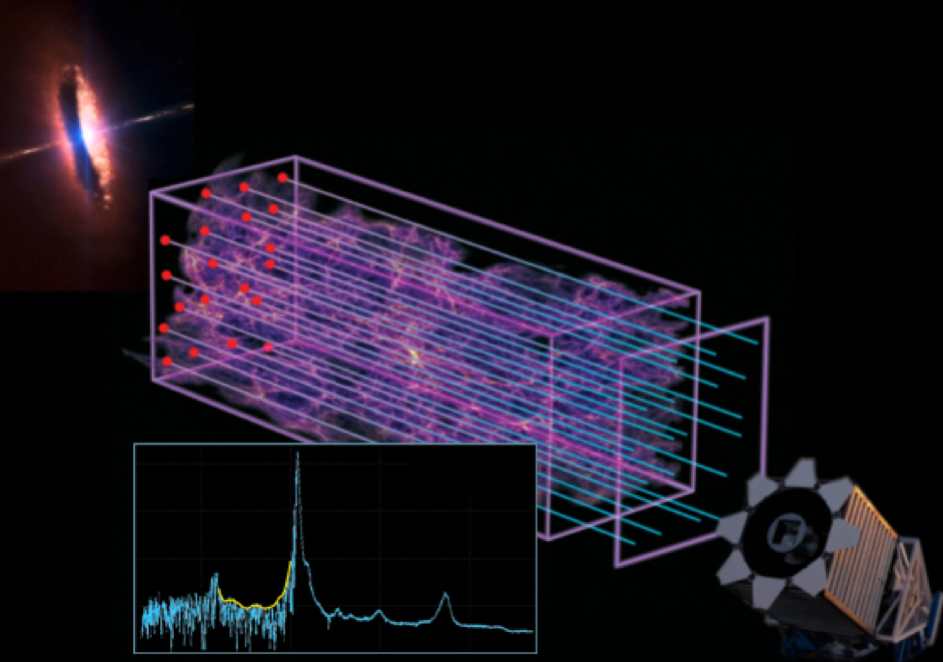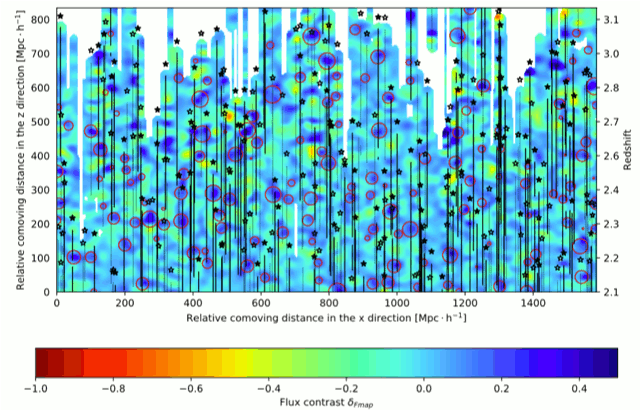Scientists from the large cosmological survey SDSS/eBOSS have constructed the first so-called "tomographic" map of the far Universe on a very large scale, which until now only existed in one dimension, along the line of sight of the ground-based telescope. To do this, they used the latest Lyman-alpha forest data, which indirectly plot the density of matter in the direction of bright objects, the quasars. The resulting map covers a cube of 3.26 billion light-years from observations of nearly 10,000 quasars. It is a new tool for studying the history of the Universe and its structures.
This work is published in the JCAP journal (arXiv:2004.01448).
Mapping matter in the Universe
The Universe is full of matter: "ordinary" matter such as that which makes up the stars, but also and above all "dark" matter whose nature constitutes one of the greatest enigmas of physics. Even on very large scales, much larger than the typical distance between galaxies, the distribution of all this matter is not homogeneous and the statistical properties of its fluctuations contain a lot of information about our Universe. We can read about the imprint of inflation, a particular period in the primordial Universe; the effect of oscillations that took place in the primordial plasma before electrons and ions recombined to form atoms; the impact of the mass of neutrinos; or the signature of dark matter’s properties such as its mass or interactions. The properties of galaxies and of the intergalactic gas also influence these matter fluctuations.
In order to map the large-scale distribution of matter, several types of astrophysical observations are available. Measuring the positions and shapes of galaxies in the Universe allows us to measure the distribution of matter in the relatively "near" - or equivalently "recent" - Universe. However, to map the Universe on a large scale at the earliest possible time (more than 10 billion years ago), the most efficient approach is currently based on a specific observation, the Lyman-alpha forest. This involves measuring the light spectra of particularly bright distant galaxies, especially quasars. We detect the effect of absorption lines - called Lyman-alpha - due to the presence of clouds of neutral hydrogen gas located between a quasar and the terrestrial observer. Thanks to the redshift effect well known in cosmology, by measuring the wavelength of each absorption line we can precisely reconstruct the position of the corresponding hydrogen cloud along the line of sight. The Lyman-alpha forest thus makes it possible to study the distribution of hydrogen on a large scale in the Universe, and this at particularly ancient times: between about 10 and 12 billion years (which corresponds to redshifts between 2.1 and 4) while the age of the Universe is 13.8 billion years.

quasars (top left) emit intense light that is partially absorbed as it passes through the intergalactic medium to the observer (central image). This creates a "forest" of absorption lines in the optical spectra of these objects, as shown in the lower left. The density of matter in the Universe is thus sampled along "1D" lines of sight represented by straight lines in the central image.

Sectional view of the tomographic map reconstructed from a fraction of the Lyman-alpha forest data. The horizontal axis represents a sky view angle of 23 degrees, and the vertical axis represents the "depth" (the redshift) of the observations. The vertical lines indicate the lines of sight of the quasars, represented by small stars. The red circles indicate the large voids in the intergalactic medium identified from the map.
A large tomographic map of Lyman-alpha
The DPhP Cosmology group is involved in the exploitation and scientific interpretation of the latest data (Data Release 16) from the Lyman-alpha forest obtained through the Sloan Digital Sky Survey (SDSS) using the 2.5 m telescope at the Apache Point Observatory in New Mexico (USA): this is the major astrophysical survey that has provided the scientific community with the majority of the observed far-field quasar spectra. The Lyman-alpha forest is by nature a one-dimensional ("1D") probe of matter, as the measurement points (the absorption lines) are all aligned along the direction of the quasars.
Nevertheless, it is possible to use tomographic algorithms to infer the 3D distribution of matter from the 1D lines of sight. This approach is similar to tomography used for example in medical imaging. The development and operation of the first 3D tomographic reconstruction of Lyman-alpha within the SDSS collaboration was coordinated by DPhP researchers. To do so, the team focused on a region of the sky called "Stripe 82", for which the sky distribution of the quasars used to measure Lyman-alpha forests is particularly dense and homogeneous, an essential criterion for the quality of the mapping. These data cover a field of 220 deg2: this constitutes only a fraction of the entire sky surface covered by SDSS, but nevertheless allows to cover the largest volume of the Universe ever mapped at such a remote time (equivalent to a volume of 1 Gpc3 of the Universe today, i.e. a cube of 3.26 billion light-years on each side!) In total, Lyman-alpha forest measurements from observations of nearly 10,000 quasars have been exploited. A similar tomography exploiting Lyman-alpha had already been obtained by another team but covered a volume about 100 times smaller.
The actual tomographic reconstruction from the Lyman-alpha “1D” data was carried out using a so-called Wiener filtering method. The most important parameter of the algorithm is a smoothing length, which sets the spatial resolution of the map at about 13 Mpc: fluctuations at scales smaller than this length cannot be correctly reconstructed because of the large separations between “1D” lines of sight. The construction of the map was validated using the eBOSS collaborative simulation and analysis tools. The data cube is publicly available and 3D visualizations of the mapped volume have been made at IRFU/DEDIP, using in particular the Sketchfab platform.
Future applications
The published map can therefore be used for several applications in cosmology. Thus, thanks to the already published map, the team has established a first catalogue of large cosmic voids detected beyond 10 billion light-years: cosmic voids are regions of intergalactic space, located between the filaments that make up the "cosmic web", for which the density of matter is particularly low.
The Lyman-alpha tomography technique used in this study will be exploited for the large DESI survey, which is currently starting and in which IRFU is widely involved. On the one hand, improvements are possible from the point of view of algorithmic developments: more advanced methods than Wiener filtering have already been developed, but studied only on simulations at this stage. On the other hand, cosmological measurements on the matter content of the Universe and the growth of large structures are accessible, using 3D matter maps to determine the properties of voids or to calculate correlations with other astrophysical objects.
The developments around this new tool, and its scientific exploitation, have only begun!
Contact: Eric Armengaud, Corentin Ravoux.
Publication: A tomographic map of the large-scale matter distribution using the eBOSS - Stripe 82 Lyα forest, arXiv:2004.01448, publié sur JCAP : https://doi.org/10.1088/1475-7516/2020/07/010
Public Data Cube: https://zenodo.org/record/3737781#.XvC84y1PjSw
3D visualisations: https://sketchfab.com/pomarede/collections/eboss-paper
• Institute of Research into the Fundamental Laws of the Universe • The Electronics, Detectors and Computing Division • The Particle Physics Division
• BAO
